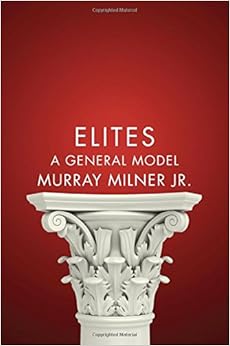Elites: A General Model applies looks at three distinctly different societies – ancient India, Classical Athens, and the contemporary United States and analyses each societies’ politicians and propagandists, landowners and capitalists, national heroes and celebrities, ordinary folks and outcasts. Marion Koob reviews.
 Elites: A General Model. Murray Milner, Jr. Polity. November 2014.
Elites: A General Model. Murray Milner, Jr. Polity. November 2014.
Whatever their epoch, elites fascinate. Their power is a marker of success; they have overseen many of history’s key turning points. Today, with our meritocratic ideals, the questions of who the elites are, whether they exist, and how much power they hold is still salient. Owen Jones has recently produced a critique of their workings in contemporary Britain, in his popular work The Establishment.
In Elites: A General Model, Murray Milner Jr, a Senior Fellow at the Institute of Advanced Studies, considers how best to analyse the upper strata of society. Can elites be divided in distinct categories reflecting concentrations of power? How do they interact with the rest of society? Building on classic works of sociology, including Marx, Weber and Bourdieu, Milner constructs a ‘general model’ as a framework for analysis, designed to produce insights on any complex society, no matter its historical period or geographical location.
Milner’s general model is made up of eight categories. The first four – political elites, economic elites — old modes of production, status elites and respectable non-elites – are each opposed to their ‘counterbalance’ or alternatives to their type of power. There are also bandits and invaders for the political, new modes of production for the economic, prophets and renouncers for status elites, and non-respectable non-elites. Milner’s two key theoretical innovations are the inclusion of status elites and non-elites in the model, categories either not previously considered or previously accounted for.
As an illustration, the author conducts an analysis of three very different civilisations: the Varna system in India, Athens in its ‘Classical Period’ of direct democracy during the 4th and 5th centuries BC, and the United States between 1980-2008. The book concludes with an in-depth scrutiny of the 2007-2008 financial crisis in the US.
 Photo Credit: Gerard Girbes Berges. CC-BY-NC-ND.
Photo Credit: Gerard Girbes Berges. CC-BY-NC-ND.
Milner opens his examination with the Varna Scheme. This system, he argues, is a loose framework for the social structure of Hindu Indian society. While there are up to thousands of castes (jatis) existing in India – compartmentalising social status, economic occupation, and geographical location, – these are each related, Milner states, to one of the four Varna categories.
From at least 2,000 years of existence, the Varna scheme is remarkable for its longevity. This, the author contends, is in part due to the ideological dominance of status elites – Brahmins – in the system. While political or economic power can be conquered, status is relatively inalienable, especially if, as is the case with Brahmins, it is rooted in religious virtue. In addition, up until recent times, political and economic conditions had not changed sufficiently in India to provoke a shift in the Varna social structure.
Brahmins live a life governed by rituals, geared towards preserving purity, and difficult to imitate for other Varna categories. Brahmins’ ‘counterbalance’ of power are Gurus, who renounce any engagement with worldliness. Kshatriyas are the political elites, while Vaisyas are defined as economic elites. Yet, Vaisysas are an anomalous category with regards to Milner’s model. While they once used to refer to farmers and herders, over the last 1,000 years, the division has been identified with merchant castes. Agrarian economic elites do not exist within this category, but they do within others, thus conflicting with Milner’s conceptualisation.
The author attempts to resolve this mismatch by using an instance of classification from South India, split between right and left castes, with each representing a different mode of production. However, it seems that this system is specific to the region, and as such is not clearly linked to the existence of the Varna scheme as a whole.
The author struggles in turn to identify the ‘counterbalance’ to political elites – bandits. He quotes an analysis of Vedic literature to demonstrate that dacoits (bandits) existed and that they were disliked by the rest of society. This is hardly surprising stuff, and it fails both to produce noteworthy insights and to identify a credible threat to the legitimacy of political elites.
One of the driving arguments of Elites is that the general model is universally applicable to complex societies. As such, these two unconvincing shortcuts weaken the author’s case. They are also likely the product of choosing a very wide time period of analysis, for which it is be difficult to state much beyond generalisations.
In the United States 1980-2008, Milner maintains that economic elites have held ideological dominance, holding greater legitimacy than either political or status elites. For instance, he remarks that government intrusions on privacy provoked an outcry in American society, while similar practices undertaken in the name of business encountered little scrutiny. Enterprise and innovation is seen as the preserve of the private sector, yet many key and transformative inventions have been products of government efforts, such as the basis of the Internet, satellites, and several modern drugs.
Milner’s analysis falters on some points. While he makes a persuasive case for the supremacy of economics over political elites, it is not clear why the category of status elites (which includes celebrities) is not overall prevailing. The case could be made that non-elites lend more legitimacy to the latter, as non-elites seek to emulate status elites to a greater extent than successful entrepreneurs, hence granting them more power. Unfortunately, this section also lacks rigour. It refers to events beyond 2008, and also to examples outside of the United States to illustrate arguments.
The proposition of Elites: A General Model is intriguing. A comparison of elite groups across different cultures and time periods could result in an interesting evaluation of the nature and concentration of power, and its relationship to social change. Regrettably, this book fails to live up to its promise. While each of the three analyses contain thought-provoking remarks, they are overall too generalised. The variation and lack of precision within each time-frame hinders, rather than enhances Milner’s argument that the model is applicable to any complex society. And while the author is at pains to underline that the wide application of his model allows for comparative work, he spends only 800 words drawing comparative conclusions from his three areas of studies.
The author’s purpose in Elites: A General Model is to advertise the model for wider use, but any attempt to sell a theoretical concept is most persuasive through an effective demonstration, rather than reiterated statements of its benefits.
————————————————————————-
Marion Koob has a BSc in Government and Economics at the LSE and and MPhil in International Relations at the University of Cambridge. She has worked in Polis, the LSE’s journalism think-tank, and is now at the British Film Institute. Read more reviews by Marion.






